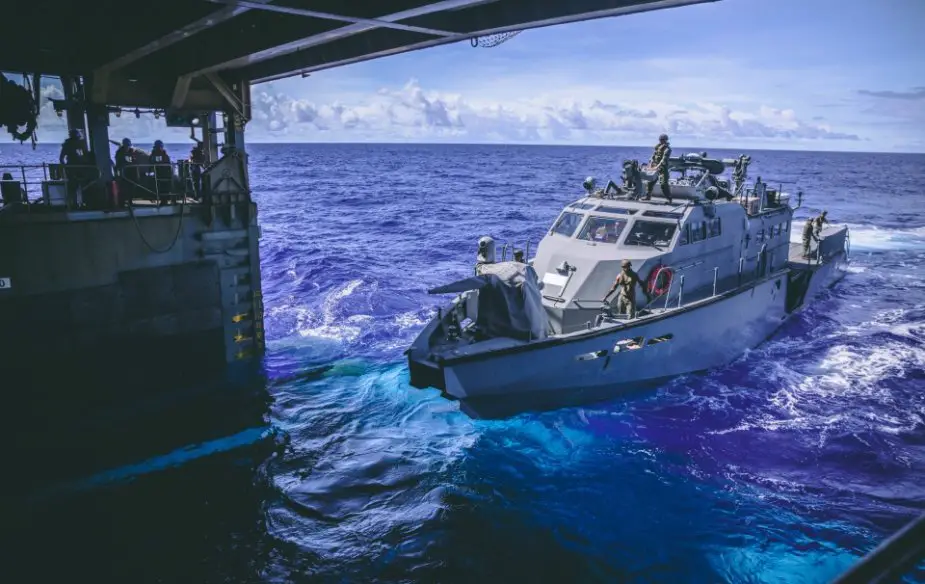USS Comstock (LSD 45) is underway after loading Mark VI patrol boats and expeditionary mine countermeasure (ExMCM) elements in Guam to integrate Navy expeditionary forces aboard the amphibious dock landing ship for a security patrol in the Philippine Sea.
Follow Navy Recognition on Google News at this link
 Patrol Boat PB Mk VI 1206 assigned to Maritime Expeditionary Security Squadron 3 prepares to board the amphibious dock landing ship USS Comstock (LSD 45), Oct. 4, 2020 (Picture source: U.S. Marine Corps/Sgt. Manuel A. Serrano)
Patrol Boat PB Mk VI 1206 assigned to Maritime Expeditionary Security Squadron 3 prepares to board the amphibious dock landing ship USS Comstock (LSD 45), Oct. 4, 2020 (Picture source: U.S. Marine Corps/Sgt. Manuel A. Serrano)
“This level of integration of Mark VI patrol boats with surface Navy assets has never been accomplished before,” said Lt. Andy Bergstrom, Alpha Company Commander. “The Mark VI patrol boat provides a presence capability in the littorals beyond sheltered bays and harbors with additional mission capabilities including high value asset escort, visit, board, search and seizure support and theater security cooperation.”
Maritime Expeditionary Security Force and Explosive Ordnance Disposal Mobile Unit Sailors assigned to Commander, Task Force 75 (CTF 75) embarked Comstock to conduct littoral maritime security operations with the Marines and Sailors already deployed as Task Force Ellis from 1 Marine Expeditionary Force.
”Navy expeditionary combat forces embarking USS Comstock to support Commander, Task Force 76 (CTF 76) is a perfect example of 7th Fleet’s tactical interoperability, operational reach, and strategic focus on regional stability,” said Capt. Gareth Healy, commander of Navy Expeditionary Forces Command Pacific/CTF 75. “Our maritime expeditionary security and ExMCM elements bring an expanded capability to clear, secure, build, and protect critical lines of communication in this dynamic area of operations.”
The interoperable patrols with Navy and Marine Corps expeditionary forces allow them to increase their ability to respond to threats, deter hostilities and maintain stability in the Indo-Pacific. “The Mark VI patrol boats provide increased mission capabilities to the amphibious ship,” said Bergstrom. “They can operate directly in support of the amphibious ship or independently in support of mission tasking. It is a mutually beneficial relationship providing increased operational readiness for both the ship and the Mark VI.”
Maritime Expeditionary Security capabilities and the growing fleet integration contribute to the high-end fight to reinforce blue-water operations and dominate the shorelines. “Our Navy and Marine Corps team continues to boldly employ cross-domain capabilities, particularly with our allies and partners, underscoring our commitment to theater security,” said Healy.
CTF 75 is 7th Fleet’s primary expeditionary task force and is responsible for the planning and execution of maritime security operations, explosive ordnance disposal, diving, engineering and construction, and underwater construction. Additionally, it provides direct support to diving and salvage operations and expeditionary intelligence throughout the Indo-Pacific region.
CTF 76/Expeditionary Strike Group Seven is the Navy’s only forward deployed amphibious force and is responsible for conducting expeditionary warfare operations to support a full range of theater contingencies, ranging from humanitarian and disaster relief to full combat operations, to ensure security and stability in the Indo-Pacific. U.S. 7th Fleet is the largest numbered fleet in the world, and with the help of 35 other maritime-nation allies and partners, the U.S. Navy has operated in the Indo-Pacific region for more than 70 years.



